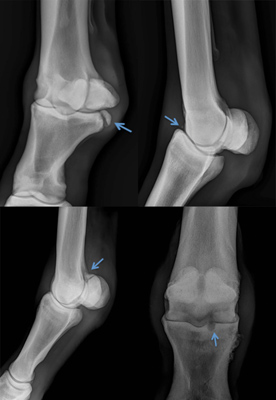 Boney fragmentation in the fetlock joint is a condition seen across multiple breeds and disciplines of horses that may impact a horse’s future performance and career longevity.
Boney fragmentation in the fetlock joint is a condition seen across multiple breeds and disciplines of horses that may impact a horse’s future performance and career longevity.
Fragments in the fetlock joint can occur both as a result of trauma and as a form of developmental orthopedic disease (Osteochondritis Dissecans (OCD) or Subchondral Cystic Lesions). Multiple sites in the joint can be affected, including: the dorsal sagittal ridge of the cannon bone, the distal and/or palmar aspect of the cannon bone, and multiple sites at the proximal aspect of the first phalanx (dorsal or palmar/plantar medial or lateral eminences, or in cysts the articulating surface of the first phalanx medial or lateral to the sagittal groove). Fragments originating from the proximal sesamoid bones are usually considered to be traumatic in nature and are unlikely to be a result of a developmental orthopedic abnormality.
Horses with fragments or cysts in the fetlock joint(s) may or may not show signs of decreased performance, clinical lameness, and pain on flexion of the digit. Whether the horse is lame or not, the joint is often visibly effusive (swollen). Definitive diagnosis of boney fragmentation or subchondral cystic lesions in the fetlock joint is made radiographically. Additional information as to the location of the fragment and potential soft tissue involvement can be gained using ultrasonography. Loose fragments and/or cysts within the joint are likely to result in progressive development of degenerative joint disease (arthritis) over time, and may eventually lead to clinical lameness even if the horse is not lame initially.
 As with other types of OCD lesions, arthroscopic removal (or debridement in the case of subchondral bone cysts) is typically the treatment of choice. Some controversy arises, however, when discussing treatment options for subchondral cystic lesions and palmar or plantar (back side of the joint) first phalanx fragments. The reason for this controversy is subchondral cystic lesions of the fetlock joint are not often accessible arthroscopically, and it may be difficult to determine if palmar or planar proximal first phalanx fragments are actually articular (within the joint space) based on radiographs. Fragments not articular (lie outside the joint capsule), are often embedded in the soft tissues of the back or palmar/plantar side of the fetlock joint, the distal sesamoidean ligaments. In these cases, arthroscopic removal will not be possible; the more invasive open approach to removal may do more harm than good, damaging ligamentous structures that make up a component of the suspensory apparatus and resulting in a longer post-operative convalescence time and potentially a less favorable prognosis. In these cases, consultation with an equine surgeon, ultrasound of the joint, and potentially diagnostic arthroscopy should be employed and used to influence further decision making for the horse. Fragments that are extra-articular and embedded in soft tissue may not affect the horse’s long-term athletic potential.
As with other types of OCD lesions, arthroscopic removal (or debridement in the case of subchondral bone cysts) is typically the treatment of choice. Some controversy arises, however, when discussing treatment options for subchondral cystic lesions and palmar or plantar (back side of the joint) first phalanx fragments. The reason for this controversy is subchondral cystic lesions of the fetlock joint are not often accessible arthroscopically, and it may be difficult to determine if palmar or planar proximal first phalanx fragments are actually articular (within the joint space) based on radiographs. Fragments not articular (lie outside the joint capsule), are often embedded in the soft tissues of the back or palmar/plantar side of the fetlock joint, the distal sesamoidean ligaments. In these cases, arthroscopic removal will not be possible; the more invasive open approach to removal may do more harm than good, damaging ligamentous structures that make up a component of the suspensory apparatus and resulting in a longer post-operative convalescence time and potentially a less favorable prognosis. In these cases, consultation with an equine surgeon, ultrasound of the joint, and potentially diagnostic arthroscopy should be employed and used to influence further decision making for the horse. Fragments that are extra-articular and embedded in soft tissue may not affect the horse’s long-term athletic potential.
As with other forms of joint disease, early diagnosis and treatment of boney lesions in the fetlock joint is critical to afford the most favorable prognosis for an athletic career. Removal of fragments which have been present in the joint for quite some time may still be of benefit to the horse by preventing further damage to the joint, however medical management of any existing arthritis will need to continue post surgery, as any cartilage damage already present will not be reversible.
Megan Williams graduated from Kansas State University and went on to an internship at Ocala Equine Hospital. She completed her surgical residency at Michigan State University. Dr. Williams is a surgeon at Saginaw Valley Equine Clinic and a lameness diagnostician with GameTime Sports Medicine at major AQHA events around the country. You can email her at megan@saginawvalleyequine.com or visit her at www.saginawvalleyequine.com. You can also write to her in care of InStride Edition.


You must be logged in to post a comment Login